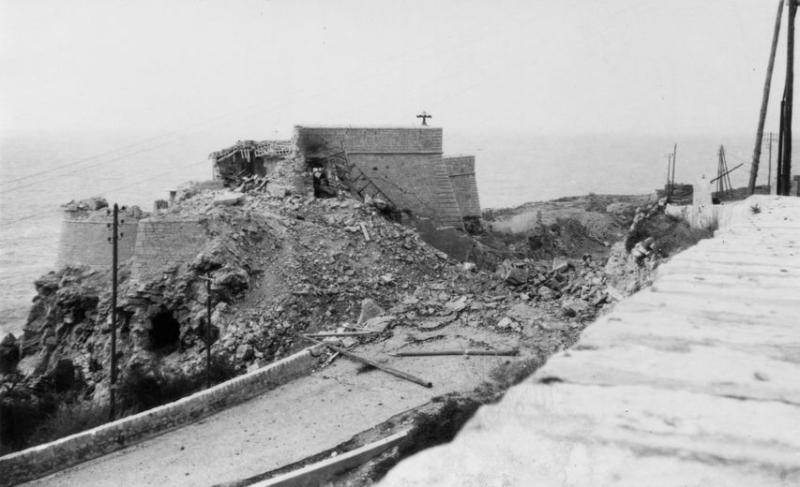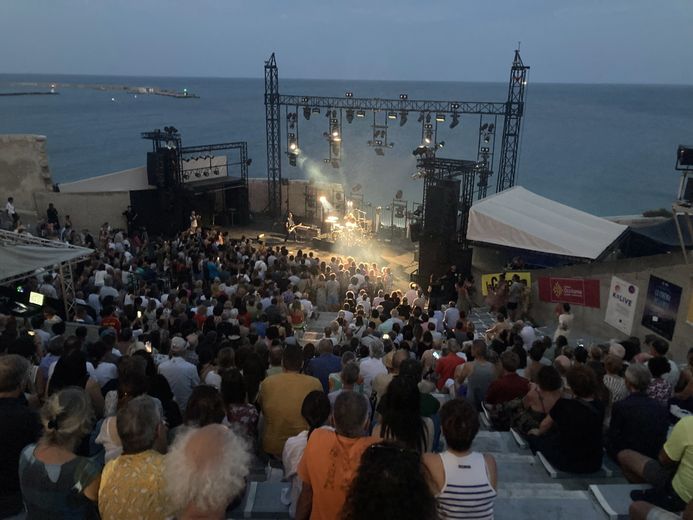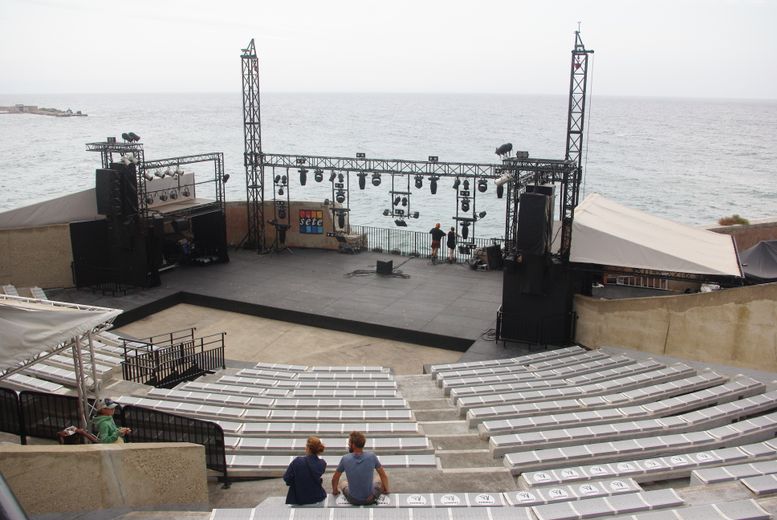A destroyed fort that became a hospice, before welcoming Claude François and Ray Charles: the crazy story of the Théâtre de la Mer in Sète

Le théâtre de la Mer, impressionnant vu du ciel, à flanc de falaises. – M. E.
Destroyed in 1944 before becoming a hospital, what is now the Théâtre de la Mer has had an astonishing history, to the point of being unanimously acclaimed today.
In 1746, construction began on what was not yet the Théâtre de la Mer. Following an attack by the English, Fort Saint-Pierre was built. It was one of the three defensive forts in the port. “The architect of this project was Antoine Niquet, a disciple of Vauban, says Jean-Renaud Cuaz, from the Historical and Scientific Society of Sète. Used as barracks during the 19th century, it also housed prisoners, including the Algerian military leader Abd-el-Kader, in 1848.”
"There was also a footbridge installed in 1898, above the current Maréchal-Leclerc promenade. The Cettois nicknamed it “the suicide footbridge”… It was in 1914, during the First World War, that the building was given to the city's hospices to be rehabilitated as a hospital."
As some know, the Théâtre de la Mer still belongs to the hospital today, which rents it to the city of Sète for 1 euro; symbolic.
From theater to music
"The fort was destroyed in 1944 when the Germans fled, explains Jean-Renaud Cuaz. The fort was converted into a theatre in 1960. At that time, it was named “Théâtre Jean-Vilar”, in homage to the actor and director from Sète.”

The fort, destroyed by the Germans in 1944.
It should also be noted that the mayor at the time, Pierre Arraud, had noted a general sensitivity of the population of Sète for art. Musicians, writers, singers and painters, made themselves known in Sète, like Georges Brassens. This is how the adventure began. The theater was revived under the leadership of Jean Deschamps. The latter planned to create a theater festival in Sète, the Festival de la Mer, in the old hospital.
Claude François in 1970
“The Marriage of Figaro” was the very first play performed at the theater, on August 13, 1960. For several years, the plays followed one after the other, before it became obsolete.
Claude François stopped there in 1970. The singer was a real success, so much so that the Sète police were forced to secure the stage. The big names finally ended up succeeding each other. In 1977, Jacques Higelin, aged 36, filled the theatre, so much so that 200 to 300 people tried to get in without a ticket. International artists such as Jimmy Cliff, Jeff Beck and Ray Charles also made an appearance there. Today, the Théâtre de la Mer still has the same vocation of encouraging culture in Sète, particularly through the many festivals.

Concerts at the Théâtre de la Mer are always exceptional moments. Midi Libre – PHILIPPE MALRIC
For many, it is one of the most beautiful stages in France. It was designed like a Roman theatre. Its stands seem to flow towards the sea, and thus captivate the spectator. Backstage, the artists enjoy a beautiful space. The corridor of the “small boxes”, under the stands, connects the two sides of the stage. At the exit of this corridor, on the garden side, we discover a view of the sea and the Môle de Sète.
An idyllic setting
The “grande loge” was renovated in the summer of 2010. Formerly the caretakers' service apartment, it has the feel of a seaside house with a terrace. The artists have 100 m2 of dressing rooms with a 60 m2 terrace. The view opens up to 180° over the Mediterranean and the stage. A privileged space to recharge your batteries. “When you love nature, combined with music, it's one of the most magical places”, Manu Dibango, a Cameroonian saxophonist and singer, has already confided.
Monumental organization
In the beginning, the capacity was not very defined. Thus, at the end of the 70s, the rocker John McLaughin had gathered 2400 people. The capacity was subsequently set at a few hundred places, before increasing to 1500 in 2006. Behind the scenes, everything is measured to accommodate the teams in a small space. Before the concerts, we witness a real ballet. There are about thirty of them working in shifts in the theater. “Each concert is different, and each artist can come with their own staff, sometimes even their own lighting,” confides David Urbach, director of the theater.

The Théâtre de la Mer currently has a capacity of 1,500 seats.
The equipment is stored under the large dressing rooms. It is mostly provided by a service company, whether it is lighting or sound equipment. The difficulties for the technicians lie in the fact that the stage is not parallel to the stands, and the weather can sometimes make the installation perilous. A job for connoisseurs, to enchant the eyes of the spectators.
And to visit ? Unfortunately, the Théâtre de la Mer only opens its doors for Heritage Days…
I subscribe to read the rest




